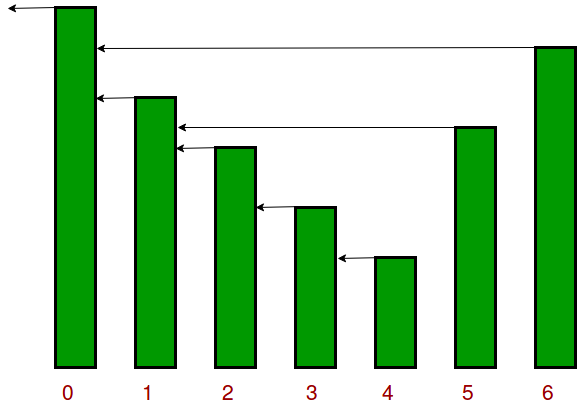Last active
April 6, 2020 05:03
-
-
Save dsapandora/53396ada6f4c47858d44ec4f4ab31cc3 to your computer and use it in GitHub Desktop.
Stock Span
This file contains bidirectional Unicode text that may be interpreted or compiled differently than what appears below. To review, open the file in an editor that reveals hidden Unicode characters.
Learn more about bidirectional Unicode characters
| // C++ program for a linear time solution for stock | |
| // span problem without using stack | |
| #include <iostream> | |
| #include <stack> | |
| using namespace std; | |
| // An efficient method to calculate stock span values | |
| // implementing the same idea without using stack | |
| void calculateSpan(int A[], int n, int ans[]) | |
| { | |
| // Span value of first element is always 1 | |
| ans[0] = 1; | |
| // Calculate span values for rest of the elements | |
| for (int i = 1; i < n; i++) { | |
| int counter = 1; | |
| while ((i - counter) >= 0 && A[i] >= A[i - counter]) { | |
| counter += ans[i - counter]; | |
| } | |
| ans[i] = counter; | |
| } | |
| } | |
| // A utility function to print elements of array | |
| void printArray(int arr[], int n) | |
| { | |
| for (int i = 0; i < n; i++) | |
| cout << arr[i] << " "; | |
| } | |
| // Driver program to test above function | |
| int main() | |
| { | |
| int price[] = { 10, 4, 5, 90, 120, 80 }; | |
| int n = sizeof(price) / sizeof(price[0]); | |
| int S[n]; | |
| // Fill the span values in array S[] | |
| calculateSpan(price, n, S); | |
| // print the calculated span values | |
| printArray(S, n); | |
| return 0; | |
| } |
This file contains bidirectional Unicode text that may be interpreted or compiled differently than what appears below. To review, open the file in an editor that reveals hidden Unicode characters.
Learn more about bidirectional Unicode characters
| # Python linear time solution for stock span problem | |
| # A stack based efficient method to calculate s | |
| def calculateSpan(price, S): | |
| n = len(price) | |
| # Create a stack and push index of fist element to it | |
| st = [] | |
| st.append(0) | |
| # Span value of first element is always 1 | |
| S[0] = 1 | |
| # Calculate span values for rest of the elements | |
| for i in range(1, n): | |
| # Pop elements from stack whlie stack is not | |
| # empty and top of stack is smaller than price[i] | |
| while( len(st) > 0 and price[st[-1]] <= price[i]): | |
| st.pop() | |
| # If stack becomes empty, then price[i] is greater | |
| # than all elements on left of it, i.e. price[0], | |
| # price[1], ..price[i-1]. Else the price[i] is | |
| # greater than elements after top of stack | |
| S[i] = i + 1 if len(st) <= 0 else (i - st[-1]) | |
| # Push this element to stack | |
| st.append(i) | |
| # A utility function to print elements of array | |
| def printArray(arr, n): | |
| for i in range(0, n): | |
| print (arr[i], end =" ") | |
| # Driver program to test above function | |
| price = [10, 4, 5, 90, 120, 80] | |
| S = [0 for i in range(len(price)+1)] | |
| # Fill the span values in array S[] | |
| calculateSpan(price, S) | |
| # Print the calculated span values | |
| printArray(S, len(price)) |
Sign up for free
to join this conversation on GitHub.
Already have an account?
Sign in to comment
We see that S[i] on day i can be easily computed if we know the closest day preceding i, such that the price is greater than on that day than the price on day i. If such a day exists, let’s call it h(i), otherwise, we define h(i) = -1.

The span is now computed as S[i] = i – h(i). See the diagram.
To implement this logic, we use a stack as an abstract data type to store the days i, h(i), h(h(i)) and so on. When we go from day i-1 to i, we pop the days when the price of the stock was less than or equal to price[i] and then push the value of day i back into the stack.
O(n). It seems more than O(n) at first look. If we take a closer look, we can observe that every element of array is added and removed from stack at most once. So there are total 2n operations at most. Assuming that a stack operation takes O(1) time, we can say that the time complexity is O(n).